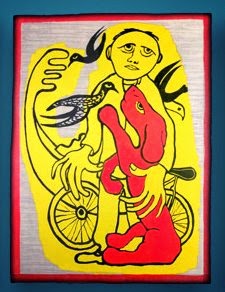We emerged from the pine forest in Marina di Bibbona as the sun was beginning to set over the Mediterranean Sea. The beach was empty except for a few fisherman casting long rods and a dog romping in the sand. Nearby was a small building that resembled so many others up and down the Tuscan coast - a place where you might rent a beach umbrella and maybe grab a quick snack. Yet this strana baracca as Chef Luciano Zazzeri likes to call it, is home to La Pineta, one of Italy's great restaurants known for its wonderful seafood. The restaurant takes its name from the Tuscan coastal pine forests that were cultivated for their pine nuts as far back as Roman times. La Pineta, the restaurant, was the reason we and two of our friends were here.
Before going down to the sea, we had spent the end of the afternoon in the original medieval village of Bibbona that sits on a nearby hill. The town's name is Etruscan in origin, but much of that early history is lost. Bibbona is first mentioned by that name in 1040. In the 1100s there are records of a dispute between Ugo della Gherardesca and the bishop of nearby Lucca over feudal rights in the area.
The village - lovely and quiet on this weekday afternoon - is built in a series of concentric circles, connected by narrow streets and steep steps. Its center is the 11th-12th century church of Sant'Ilario. Like many villages in Tuscany, its position on a hill was not only for defensive purposes, but also to lift the town above the unhealthy swamps and marshes that covered much of the lowlands in ancient times. Today's Tuscany of vineyards and olive groves that most people know and love is the result of successive draining projects over several centuries.
It was during one of these draining projects in the middle of the 18th century that Marina di Bibbona came into existence, but it was not until 1980s that any significant building took place in the town.
When La Pineta opened there in the spring of 1964, it was just a little place on the beach with 12 changing huts and 12 umbrellas. Present chef Luciano Zazzeri was nine years old, but he was already in the restaurant's kitchen. He learned to cook from his grandmother, his mother and his aunt, who were preparing the dishes that attracted tourists just beginning to discover the region. In later years, the restaurant also attracted the attention of the great wine families in the nearby Bolgheri region, where Super Tuscans are produced. Among the diners were members of the Della Gherardesca family, descendants of the the same family mentioned in 12th-century records of the area.
From the outside, La Pineta still looks like a beachside shanty. Inside, however, the dining tables are covered in heavy linen cloths and the crystal and silver glimmer in the soft lighting. The view that fills the windows is the great expanse of the Mediterranean Sea.
The sea fades from view, however, when the food is set before you. You can order a la carte, but there are also two seafood tasting menus served to a minimum of two people. Since we were four, we ordered both menus, giving us a taste of 11 different dishes. Every one of them was wonderful. The fish is fresh from the sea, the pasta is perfectly al dente, and the vegetables are cultivated in the restaurant's garden. The dishes, although elegantly presented, are relatively simple. The flavor of the fresh fish is first and foremost, as in a baccala on a puree of leeks or in a simple baked fish with rosemary, capers, olives and tomatoes. The wine list is extensive and is heavy on Tuscan wines, including many of the best Bolgheri wines.
The atmosphere is relaxed and the waiters linger to chat when they take away the dishes. Chef Zazzeri stopped by as well to talk to us about the different fish and how they were prepared. When we were leaving, he walked us to the door and in traditional Italian style, lingered there with us for ten minutes or more, talking about the politics of Italy, the vagaries of the restaurant business, his family and his passion for food. We seemed to diverge a bit on politics, but we were in perfect harmony on the pleasures of good food.
To see more photos, click here.
A presto,
Geraldine
Via Dei Cavalleggeri Nord 27
57020 Marina Di Bibbona, Toscana, Italy
Telefono (0039) 0586.600016
Photos by Geraldine Calisti Kaylor


